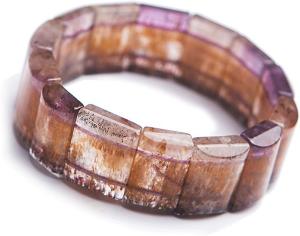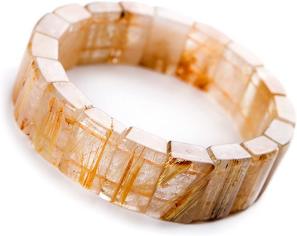Gemstone inclusions are tiny specks or patterns you notice while gazing into a gemstone. These natural features, hold the secret history of how each gem was formed. They add character and uniqueness, making every stone truly special. In this guide, we’ll explore the fascinating world of gemstone inclusions, uncovering how they affect a gem’s beauty, value, and the stories they tell.
Macro photography of a natural diamond with an inside inclusion. The diamond measures 1×1 mm and was photographed without the help of a microscope. |
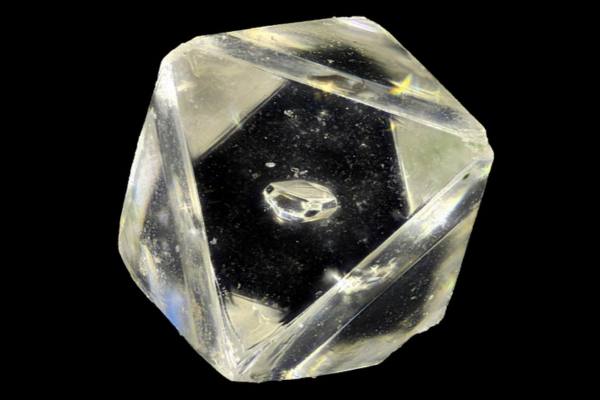
|
| Giuliofranzinetti, CC BY-SA 4.0, via Wikimedia Commons |
Table Of Contents
- 1) What Is an Inclusion in a Gemstone?
- 2) Different Types of Inclusions Found in Gemstones.
- 3) How Inclusions Impact Gemstone Quality.
- 4) When Gem Inclusions Enhance Beauty.
- 5) Identifying Natural Gemstones Through Their Inclusions.
- 6) Common Inclusions in Popular Gemstones.
- 7) Appreciating the Beauty of Inclusions.
- 8) Examining Inclusions with Gemological Tools.
- 9) Caring for Gemstones with Inclusions.
- 10) Conclusion.
<
|
|
What Is an Inclusion in a Gemstone?Back To Top |
Think of inclusions as the gemstone’s personal diary, recording the Earth’s secrets within its crystalline structure. These natural features—tiny bits of minerals, liquids, or gases—are trapped inside the gem as it forms, offering a unique glimpse into its origin story.
Unveiling the Secrets Inside Gemstones
Ever noticed tiny marks or patterns inside a gemstone? These are inclusions—natural materials like minerals, liquids, or gases that got trapped inside the gem as it formed. Rather than being mere imperfections, inclusions are like the gemstone’s birth certificate, revealing its unique formation story. They add character and individuality, making each stone one-of-a-kind. By studying these internal features, we gain insight into the gem’s origin and the geological conditions it experienced deep within the Earth.
How Inclusions Form During Gemstone Creation
Gemstones develop under extreme heat and pressure far beneath the Earth’s surface. During this process, they grow from mineral-rich fluids or molten rock. As crystals form, they might capture tiny particles of other minerals, droplets of liquid, or even pockets of gas present in their surroundings. These trapped substances become inclusions. The environment where gemstones grow is rarely pure; it’s a dynamic mix of elements constantly interacting. Inclusions are like snapshots of this tumultuous creation period, frozen in time within the gem. They not only make each gemstone unique but also offer a window into the Earth’s deep and complex processes.
|
|
Different Types of Inclusions Found in GemstonesBack To Top |
Gemstone inclusions come in all shapes and sizes, adding unique character to each stone. Understanding these different types helps us appreciate the hidden wonders inside every gem.
Solid Inclusions in Gemstones: Minerals Within Minerals
A Gemstone’s Hidden Guests
Solid inclusions are like tiny guests residing within a gemstone. These are bits of other minerals that got trapped inside the gem as it formed deep underground. Imagine a speck of pyrite nestled inside quartz or slender rutile needles in sapphire. These mineral inclusions create fascinating patterns, sometimes enhancing the gemstone’s beauty and uniqueness.
Clues About a Gem’s Origin
These solid inclusions aren’t just pretty to look at—they provide valuable clues about where and how the gemstone formed. Gemologists study them to trace the gem’s geological history, since certain mineral inclusions are specific to particular locations or conditions.
Liquid and Gas Inclusions: Nature’s Tiny Bubbles
Tiny Time Capsules
Liquid and gas inclusions are microscopic pockets of fluid or gas trapped during the gem’s formation. Think of them as time capsules preserving ancient substances from when the Earth was still young. In some cases, these inclusions contain millions of years old water.
The Magic of Moving Inclusions
In certain gemstones, like enhydro quartz, the liquid inclusions can move when you tilt the stone. It’s like holding a miniature ocean in your hand. Gas inclusions might appear as tiny bubbles or voids, adding a unique sparkle or haziness to the gem.
This Quartz Stone Has Petroleum Inclusions |
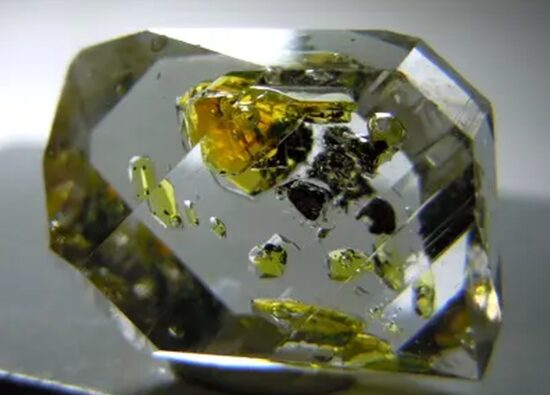
|
This quartz stone has petroleum inclusions. Photo by Luciana Barbosa. Licensed under CC By-SA 3.0
Halo or Disk-like inclusions:
When zircon crystals grow inside the host gemstone they cause fractures in the crystalline structure of the host. This happens because the two crystals have different thermodynamic and chemical properties. These fractures assume the shape of discs and are referred to as halos. Disk-like inclusions are seen in sapphires, garnets and peridots.
The reflective, disk-shaped inclusions seen in natural Peridots are imaginatively called “lily pads.” A lily pad proves that a peridot is natural.
Solid inclusions can also include pyrite deposits found in lapis lazuli and green mica deposits in aventurine.
Crystals:
A crystal inclusion is an included crystal of any other mineral specimen or that of the host mineral itself.
It can be a pre-existing crystal entrapped by the growing host crystal. This is an example of an Antegenic Inclusion. It could have grown on the wall of a cavity in the host crystal.
It could be born out of crystallisation of liquid or gaseous chemicals trapped inside the host crystal.
Sheaves:
These inclusions composed of the mineral cacoxenite (iron aluminium phosphate) are seen in gemstone amethyst. They are a collection of yellow sheaf-like crystal groups.
Bubbles:
These are actual bubbles of different sizes and shapes seen inside the gem. And the bubbles could be either liquid or gaseous bubbles.
A liquid can get caught within the growing crystal at any stage of growth. It can even seep into the crystal after completion of growth. In some instances, the liquid is catalyzed when part of the host crystal or an included mineral dissolves chemically. You should note that bubbles are often a clue to synthetic gemstone or cheap glass imitation.
Cleavage Fault:
Cleavage fault is not an inclusion of a foreign body inside the gem. It is in fact a straight crack in a gemstone’s cleavage plane. It is manifested in diamonds, topaz, kunzite & feldspar.
Virtually all gemstones are crystals displaying well defined crystalline structure. One inherent feature of crystals is that they have cleavage. It is the susceptibility of a crystal to break cleanly along distinct planes.
Feather:
‘Feather’ is a general term for fissures that might exist in a gemstone. These are shattered hairline cracks within the stone that resemble feathers. Small feathers do not usually threaten the gemstone’s structure unless they rise to the surface on the top of the stone, where they are prone to accidental blows.
Flakes:
Green aventurine quartz is actually colorless quartzite. Tiny flakes of green fuchsite mica present in the crystal imparts the color.
Rain:
These are ethereal dashed patterns akin to raindrops and rain-like structures looking like comets.
Twinning:
This inclusion is oftentimes found in rubies and Sapphire. It is considered to be evidence of genuineness of the gemstone. It looks like cracked parallel planes.
Crystal twinning occurs when two separate crystals share some of the same crystal lattice points in a symmetrical manner. The result is an intergrowth of two separate crystals in a variety of specific configurations. Gemologists use the type of twinning seen in a gem as a diagnostic tool in mineral identification.
Veil:
Veils are small inclusions arranged in layer structures that look like bubbles. These inclusions can be wispy, flat or curvaceous.
Synthetic gems contain inclusions specific to their method of growth. These include translucent to opaque coloring, coarseness, and a web-like appearance. Such inclusions contrast starkly with the natural, transparent, partially healed fracture “fingerprint” inclusions.
For example, translucent to opaque-white to yellowish granular-looking flux are types of inclusions you would typically find in a flux-grown synthetic stone.
Multiphase Gemstone Inclusions: A Mix of Elements
Multiphase inclusions are the most intricate of all. They contain a combination of solids, liquids, and gases all in one tiny inclusion. Imagine a miniature scene inside the gem, with crystals floating in liquid alongside gas bubbles.
Why They Matter
These complex inclusions offer a deeper glimpse into the geological processes that created the gemstone. They’re fascinating to both gem collectors and scientists because they hold so much information about the Earth’s inner workings.
|
|
How Inclusions Impact Gemstone QualityBack To Top |
Inclusions play a significant role in determining a gemstone’s beauty and value. They can diminish a gem’s appeal or add unique characteristics that make it stand out.
The Role of Inclusions in Clarity Grades
Understanding Clarity and Its Importance
Clarity refers to the absence of internal flaws or inclusions within a gemstone. Gemologists assess clarity grades by examining inclusions’ size, number, position, and visibility under magnification. A gemstone with fewer and less visible inclusions typically receives a higher clarity grade, which often translates to greater value. For example, in diamonds, clarity is one of the key factors that determine price, along with color, cut, and carat weight.
Impact on Light Performance
Inclusions can affect how light passes through a gemstone, influencing its brilliance and sparkle. Large or numerous inclusions may disrupt the path of light, causing the gem to appear dull or cloudy. This is particularly important in transparent stones like diamonds and sapphires, where optimal light performance is highly prized.
Considerations for Gem Buyers
Understanding the role of inclusions in clarity grades helps buyers make informed decisions. While flawless gemstones are rare and often expensive, stones with minor inclusions not visible to the naked eye can balance beauty and affordability. Knowing what to look for ensures you get the best value without compromising appearance.
|
|
When Gem Inclusions Enhance BeautyBack To Top |
Creating Unique Optical Phenomena
Some inclusions contribute to stunning optical effects that enhance a gemstone’s allure. For instance, tiny needle-like inclusions in star sapphires create a phenomenon called asterism, where a star-shaped pattern appears on the surface when light shines upon it. Similarly, fibrous inclusions in certain chrysoberyl gems produce chatoyancy, giving the mesmerizing “cat’s eye” effect.
What Is Rutile and How Does It Shape Gemstones?
Rutile is a naturally occurring mineral composed primarily of Titanium Dioxide (TiO2). Its remarkable tendency to form needle-shaped inclusions within other minerals, particularly quartz, gives rise to rutilated quartz—a gem prized for its unique internal patterns.
Click On The Images
Rutile’s Role in Creating Mesmerizing Optical Effects
Rutile inclusions play a critical role in creating stunning optical effects in gemstones. They are responsible for the chatoyancy seen in Chrysoberyls and the asterism effects that bring star rubies and star sapphires to life.
The Enchanting Silk of Rutile Needles in Rubies
In rubies, rutile inclusions often intersect in tight formations, creating a pattern known as silk. These slender, needle-like structures may appear long or short and are sometimes woven tightly together, adding depth and complexity to the gem.
Stars and Cat’s Eyes: The Magic Within Crystals
From within the depths of mineral crystals, rutile needles create breathtaking optical phenomena. When light reflects off these inclusions, star patterns or cat’s eyes emerge. The orientation and growth of the needles determine whether the effect is a shimmering star or a captivating cat’s eye.
How Chatoyancy Brings Gems to Life
Chatoyancy, or the “cat’s eye” effect, occurs when a gemstone contains a profusion of silk-like inclusions. Light reflects off these aligned rutile or hematite needles, forming a striking band across the gem’s surface, reminiscent of a feline’s eye.
Asterism: The Starry Wonder of Rutile Needles
Rutile needles also produce the phenomenon of asterism, where a sharp, six-rayed star dances across the surface of gems like star rubies and star sapphires. Best viewed under a single light source, this effect makes star gems highly coveted and exceptionally valuable.
Black Shale Gemstone Inclusions:
An eye-catching example of black shale inclusion occurs in trapiche gemstones which is prominintly seen in trapiche emeralds. This unusual gem is almost exclusively found in the Muzo mining district of Colombia.
It’s distinctive signature characteristic is the ray-like inclusion originating from its center in a hexagonal pattern resembling the spokes of a wheel. The phenomenon is caused by coal-like shale inclusions that happen to form in the wheel-spoke pattern. Trapiche is the Spanish word for the cogwheel used to crush sugarcane.
Extremely rare cases of non-Colombian trapiche emerald crystals have been seen in the Brazilian state of Goiás and Mananjary area in Madagascar.
Other gems that occasionally display trapiche property are rubies, tourmalines, chiastolites, and garnets.
Hematite Gemstone Inclusions:
Hematite is also known as haematite. The name stems from the Greek word for blood.
It occurs in many formations inside the quartz crystal. Deep blood-red crystals, neat columns of hexagonal platelets, radiating needle-like patterns or thread-like filaments are some of the strains of Hematite manifestations.
Dendritic Gemstone Inclusions:
These are fern-like inclusions of iron, manganese, or other metallic oxides known as dendrites. They are seen in Quartz and Agate and make intricate vegetal patterns on the surface of the gemstones. They look like hand-painted calligraphy sketches but are, in fact, completely natural phenomena.
Adding Character and Individuality
Inclusions can make a gemstone truly unique, adding character that sets it apart from others. They act as natural fingerprints, telling the story of the gem’s formation deep within the Earth. Collectors and enthusiasts often cherish these imperfections for the individuality they bring.
Embracing Natural Beauty
Many gem lovers appreciate inclusions as a testament to a gemstone’s natural origin. Rather than viewing them as flaws, they see inclusions as intriguing features that highlight the gem’s journey over millions of years. This perspective allows for a deeper connection with the stone, celebrating its natural beauty in its entirety.
|
|
Identifying Natural Gemstones Through Their InclusionsBack To Top |
Inclusions are more than tiny imperfections—they’re natural markers that reveal a gemstone’s true identity. By studying these internal features, we can differentiate precious gemstones mined from the Earth from synthetic ones created in a lab.
Inclusions as Nature’s Fingerprints
Every gemstone has unique inclusions that act like nature’s fingerprints. These inclusions are often materials such as crystal, mica, or rutile needle inclusions found within the gemstone. They tell the story of how the gemstone was formed deep underground.
Peridot’s Signature: The ‘Lily Pad’ Inclusion
Peridot, the vibrant green gemstone, often showcases unique disc-like inclusions known as “lily pads.” These reflective, disk-shaped inclusions are common in peridot and are descriptively called lily pads.
These Disk-Like Fracture Inclusions In Peridot Are Descriptively Called Lily Pads. |
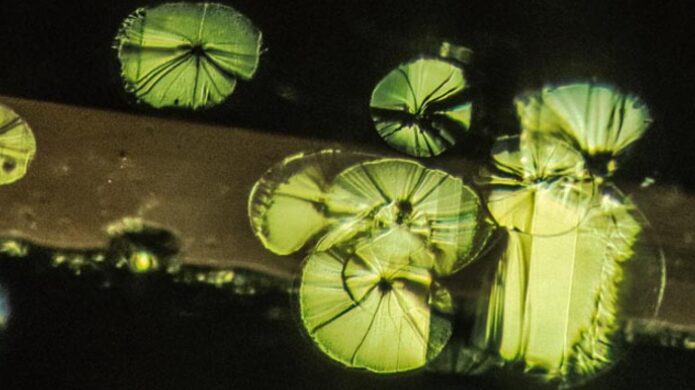
|
| Image Credit And Source: https://www.gia.edu/peridot-quality-factor |
This Peridot From Pakistan Contains Lily Pad Inclusions and Also The Needle-Like Crystals Of Ludwigite. |
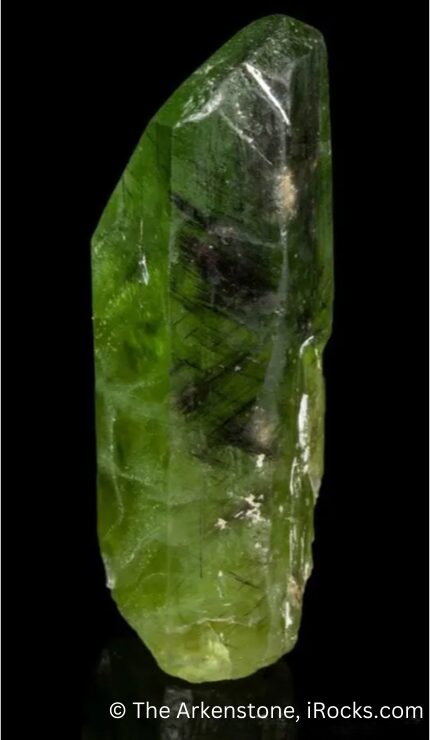
|
© Rob Lavinsky, www.iRocks.com
Demantoid Garnet’s Distinctive ‘Horsetail’ Inclusions
Demantoid garnets are renowned for their captivating “horsetail” inclusions, which are actually fibers present in some demantoids from the Ural Mountains (Russia) but also from Val Malenco (Italy), Baluchistan (Pakistan), as well as from Kerman (Iran). These inclusions not only enhance the gem’s allure but also serve as indicators of its origin.
Emerald’s Enchanting Calcite and Three-Phase Inclusions
Emeralds often contain calcite or three-phase inclusions, which are fluid inclusions that consist of a liquid, a gas, and a solid crystal. These inclusions add to the gem’s allure and provide insights into its geological formation.
Gemologists utilize these unique inclusions to identify and authenticate gemstones, as they offer a glimpse into the geological processes that created these precious stones.
Spotting the Difference Between Natural and Synthetic Gems
Inclusions play a crucial role in distinguishing natural gemstones from synthetic or lab-grown ones. Synthetic gems are often free from inclusions or contain inclusions that differ from those in natural gems. The inclusions present in natural gemstones are unique and specific to their method of formation.
For example, natural glass gemstones like obsidian may contain inclusions not found in synthetic versions. By understanding inclusions, gem and jewelry experts can determine if a gemstone is perfect due to being synthetic or if it contains natural inclusions that indicate it’s been mined from the Earth.
Inclusions can also affect the value of a gemstone; gemstones with visible inclusions might be less valuable unless those inclusions enhance the beauty of the gemstone. Recognizing inclusions in diamonds or colored gemstones helps in verifying their authenticity, ensuring that the gemstone is natural and not an imitation.
|
|
Common Inclusions in Popular GemstonesBack To Top |
Different gemstones possess unique inclusions that affect their beauty and help identify them. Let’s explore how these inclusions contribute to the character of some of the most precious gemstones.
Diamonds: Understanding Common Flaws
Diamonds often contain inclusions like tiny crystals, fractures, or feather-like patterns trapped within the gemstone. These inclusions are materials that became enclosed during the diamond’s formation deep within the Earth. While diamonds are prized for their clarity, many gemstones in this category are not entirely free from inclusions. In fact, inclusions can help gemologists identify the gem as natural rather than synthetic. Understanding inclusions in diamonds is crucial because they influence the gem’s brilliance and overall value. Fewer inclusions generally mean a more valuable gemstone, but specific inclusions can also create unique patterns inside the gemstone, adding character to the piece of jewelry.
Emeralds: The Allure of “Jardin”
Emeralds are renowned for their rich green color and the mesmerizing inclusions often found within them. These inclusions, known as “jardin” (French for “garden”), consist of materials like mica inclusions and calcite inclusions trapped inside the gemstone. The presence of inclusions in emeralds is so common that they are considered part of the gem’s natural beauty. These inclusions make the gemstone look like a lush garden, enhancing its allure. Inclusions are often responsible for the unique patterns that make each emerald distinct. Rather than detracting from the value, these inclusions in emeralds are embraced as a sign that the gemstone is natural and has a fascinating history trapped within it.
Rubies and Sapphires: Silk and Needle Inclusions
Rubies and sapphires, both varieties of corundum, frequently exhibit rutile needle inclusions known as “silk.” These silk inclusions can create stunning optical effects like asterism, where a star-shaped light pattern appears on the gemstone’s surface. Inside the gemstone, these tiny needle-like inclusions scatter light in captivating ways. In some cases, the presence of inclusions enhances the beauty of rubies and sapphires, making them highly sought after. Gemstones with visible silk inclusions are unique and can be more valuable due to these specific inclusions. Understanding inclusions in these colored gemstones helps gemologists identify the gem and determine its origin, as certain inclusions are unique to particular gemstone mines.
|
|
Appreciating the Beauty of InclusionsBack To Top |
Inclusions aren’t just imperfections; they can enhance the beauty of a gemstone in unexpected ways. These tiny features inside the gemstone often create stunning visual effects that make each piece truly unique.
Optical Effects Like Asterism and Chatoyancy
Some inclusions are responsible for remarkable optical phenomena that captivate gem and jewelry enthusiasts. For instance, when rutile needle inclusions align perfectly within certain gemstones like sapphires and rubies, they produce a star-like effect known as asterism. This mesmerizing display occurs as light reflects off silk inclusions inside the gemstone, creating a radiant star that seems to glide across the surface.
Similarly, chatoyancy, or the “cat’s eye” effect, happens when fibrous inclusions are present in gemstones like chrysoberyl. These inclusions cause light to form a bright band across the gem, resembling a cat’s eye opening and closing as the stone moves. Inclusions are responsible for these captivating effects, turning ordinary gems into extraordinary pieces of jewelry.
Inclusions as Windows into Earth’s History
Beyond their beauty, inclusions are fascinating because they act as windows into Earth’s geological past. Trapped within the gemstone, inclusions can contain minerals, gases, or even liquids that existed millions of years ago. For example, three-phase inclusions found in emeralds may include a combination of gas bubbles, liquid, and tiny crystal inclusions like calcite or mica.
Studying these inclusions helps scientists understand how gemstones are formed and the conditions within the Earth’s crust at that time. Inclusions specific to their method of formation can reveal the host gemstone’s origin, such as mesmerizing horsetail inclusions found only in demantoid garnets from certain mines. By appreciating the inclusions present within gemstones, we gain a deeper understanding of our planet’s history and the incredible processes that create these precious gemstones.
|
|
Examining Inclusions with Gemological ToolsBack To Top |
To uncover the secrets hidden within gemstones, gemologists rely on specialized tools that bring these tiny wonders into focus. Examining inclusions up close satisfies curiosity and deepens our appreciation for these natural treasures. Let’s explore how these instruments reveal the fascinating details inside each gem.
Using Loupes and Microscopes
Loupes and microscopes are essential for peering into the inner world of gemstones. A jeweler’s loupe, typically offering 10x magnification, lets you see inclusions that are usually invisible to the naked eye. When you hold a gemstone up to a loupe, you might spot common crystal inclusions or tiny fractures trapped inside the gemstone. These features can affect how the gemstone can look in different lighting and settings.
Microscopes take this exploration even further by magnifying inclusions that are a fascinating part of gemology. Under a microscope, fluid inclusions filled with ancient liquids or gas bubbles become visible, revealing how the gemstone was formed. You might also observe rutile needle or silk inclusions within gemstones like sapphires, responsible for unique optical effects. Using these tools helps gemologists classify inclusions and understand how they affect the overall beauty of a gemstone.
Advanced Techniques in Gemstone Inclusions Analysis.
Advanced techniques come into play for a deeper dive into inclusion analysis. Methods like spectroscopy and X-ray imaging allow experts to study inclusions that are usually too small or complex for standard microscopes. These techniques can reveal valuable gemstone inclusions influencing a gem’s color, clarity, and overall appeal.
Advanced analysis helps identify specific inclusions found in certain types of gems. For example, fluid inclusions can affect how light passes through a gemstone, impacting its brilliance. Understanding these nuances is crucial because inclusions affect not just the aesthetic but also the value of the piece of gemstone.
Gemologists gain insights that go beyond surface beauty by employing these sophisticated tools. They can determine whether inclusions are considered beneficial or if they detract from the gemstone’s quality. This level of examination ensures that every gemstone and crystal is appreciated for its unique characteristics, making the study of inclusions a truly captivating aspect of gemology.
|
|
Caring for Gemstones with InclusionsBack To Top |
Gemstones with inclusions need special attention to keep their unique beauty intact. Proper care ensures these fascinating features remain part of the gem’s allure for a long time.
Maintenance Tips for Included Gems.
Included gemstones and crystals are often more delicate because of the internal features that make them special. Inclusions are not always stable; some can weaken the host gemstone, making it more prone to damage. To preserve your gem, avoid exposing it to extreme temperatures or harsh chemicals, which can affect both the stone and the inclusions within. Gentle cleaning with mild soap and lukewarm water is usually sufficient. Remember, inclusions are a fascinating part of your gemstone’s character, so taking these extra precautions helps maintain its charm.
Choosing Protective Settings.
When setting gemstones with many inclusions, choosing the right jewelry setting is crucial. Protective settings like bezel or halo designs offer extra security for gems that are classified as more fragile. These settings encase the gemstone, shielding it from potential knocks and scratches. Since inclusions can affect the structural strength of the gem, a sturdy setting minimizes the risk of damage. Consult with a professional jeweler who can use inclusions to help determine the best setting for your piece. By thoughtfully selecting a setting, you ensure that the beauty of your gemstone is showcased while keeping it safe over time.
|
|
ConclusionBack To Top |
As we’ve journeyed through the captivating world of gemstone inclusions, it’s clear that these tiny features add depth and character to every gem. They transform ordinary stones into extraordinary treasures, each with its own tale to tell.
Embracing the Unique Story Of Gemstone Inclusions Within Each Gemstone Crystal
Every gemstone crystal holds a story, etched by the inclusions found within it. Inclusions are usually seen as imperfections, but they are actually nature’s signatures captured inside the gem. These features, found as inclusions in various stones, make each piece truly unique. By embracing these natural markings, we not only appreciate the gem’s beauty but also connect with the incredible processes that formed it deep within the Earth.
